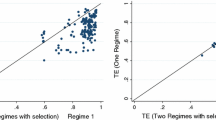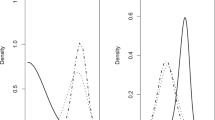Abstract
In this paper, we propose the copula-based maximum likelihood (ML) approach to estimate the multiple stochastic frontier (SF) models with correlated composite errors. The motivation behind the extension to system of SF regressions is analogous to the classical generalization to system of seemingly unrelated regressions (Zellner in J Am Statist Assoc 57:348–368, 1962). A demonstration of the copula approach is provided via the analysis of a system of two SF regressions. The consequences of ignoring the correlation between the composite errors are examined by a Monte Carlo experiment. Our findings suggest that the stronger the correlation between the two SF regressions, the more estimation efficiency is lost in separate estimations. Estimation without considering the correlated composite errors may cause significantly efficiency loss in terms of mean squared errors in estimation of the SF technical efficiency. Finally, we also conduct an empirical study based on Taiwan hotel industry data, focusing on the SF regressions for the accommodation and restaurant divisions. Our results, which are consistent with the findings in simulation, show that joint estimation is significantly different from separate estimation without considering the correlated composite errors in the two divisions.
Similar content being viewed by others
Notes
See section 2.2.2 of Trivedi and Zimmer (2005).
See Proposition 4.1 of Cherubini et al. (2004).
See Serfling (1980).
We thank the associate editor for this suggestion.
See Cherubini et al. (2004) for the details.
Tsay et al. (2012) have shown that c 1 = −1.0950081470333 and c 2 = −0.75651138383854.
Since the close form of the inverse CDF is not available, we first compute, via (10), the numerical CDF at 10,000 points, and then apply the inverse of this numerical CDF at given γ to obtain ɛ.
References
Aigner DJ, Lovell CAK, Schmidt P (1977) Formulation and estimation of stochastic frontier production models. J Econom 6:21–37
Amsler C, Prokhorov A, Schmidt P (2011) Using copulas to model time dependence in stochastic frontier models. Econom Rev (forthcoming)
Bandyopadhyay D, Das A (2006) On measures of technical inefficiency and production uncertainty in stochastic frontier production model with correlated error components. J Prod Anal 26:165–180
Battese G, Coelli T (1988) Prediction of firm-level technical efficiencies with a generalized frontier production function and panel data. J Econom 38:387–399
Carta, Steel (2010) Modelling multi-output stochastic frontiers using copulas. Comput Statist Data Anal (forthcoming)
Cherubini U, Luciano E, Vecchiato W (2004) Copula methods in finance. Wiley, New York
Genest C, Remillard B, Beausoin D (2009) Goodness-of-fit tests for copulas: a review and a power study. Insurance: Math Econom 44:199–213
Greene WH (2003) Simulated likelihood estimation of the normal-gamma stochastic frontier function. J Prod Anal 19:179–190
Greene WH (2010) A stochastic frontier model with correction for sample selection. J Prod Anal 34:15–24
Hausman JA (1987) Specification tests in econometrics. Econometrica 46(6):1251–1271
Pal M (2004) A note on a unified approach to the frontier production function models with correlated non-normal error components: the case of cross-section data. Indian Econ Rev 39:7–18
Pal M, Sengupta A (1999) A model of FPF with correlated error components: an application to Indian agriculture. Sankhyā: Indian J Statis 61:337–350
Pitt MM, Lee L-F (1981) The measurement and sources of technical inefficiency in the Indonesian weaving industry. J Dev Econ 9:43–64
Schweizer B, Sklar A (1983) Probability metric spaces. Elsevier Science, New York
Serfling RJ (1980) Approximation theorems of mathematical statistics. Wiley, New York
Shi, Zhang (2011) A copula regression model for estimating firm efficiency in the insurance industry. J Appl Statist 38(10):2271–2287
Sklar A (1959) Fonctions de Répartition à n Dimensions et Leurs Marges. Publications de l’Institut de Statistique de L’Université de Paris 8:229–231
Smith MD (2008) Stochastic frontier models with dependent error components. Econom J 11:172–192
Trivedi PK, Zimmer DM (2005) Copula modeling: an introduction for practitioners. Found Trends Econom 1(1):1–111
Tsay WJ, Huang CJ, Fu TT, Ho IL (2012) A simple closed-form approximation for the cumulative distribution function of the composite error of stochastic frontier models. Journal of Productivity Analysis, forthcoming
Wang H-J, Ho C-W (2010) Estimating panel stochastic frontier models with fixed effects by model transformation. J Econom 157(2):289–296
Zellner A (1962) An efficient method of estimating seemingly unrelated regressions and tests for aggregation bias. J Am Statist Assoc 57:348–368
Acknowledgments
Lai gratefully acknowledges the National Science Council of Taiwan (NSC-98-2410-H-194-035) for the research support. The authors thank an anonymous referee and the associate editor for helpful comments.
Author information
Authors and Affiliations
Corresponding author
Rights and permissions
About this article
Cite this article
Lai, Hp., Huang, C.J. Maximum likelihood estimation of seemingly unrelated stochastic frontier regressions. J Prod Anal 40, 1–14 (2013). https://doi.org/10.1007/s11123-012-0289-8
Published:
Issue Date:
DOI: https://doi.org/10.1007/s11123-012-0289-8




